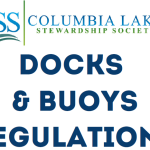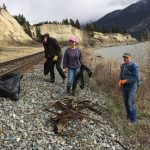Groundwater Contribution into Columbia Lake in the Vicinity of Canal Flats
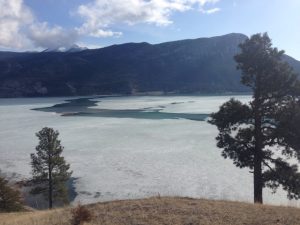
Looking east from lookout at Findlay Creek Rd and Hwy 93/95 (30 March 2018)
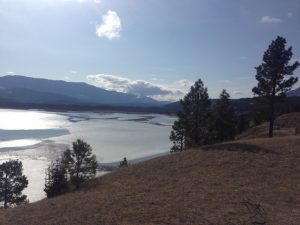
Open water and springs area- headwaters of Columbia Lake (30 March 2018)
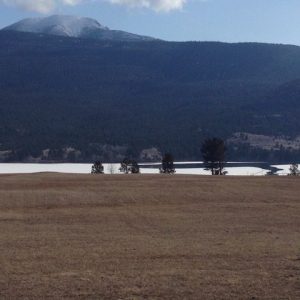
Looking east from gravel pit on Hwy 93/95 (30 March 2018)
It’s Spring! The ice is melting and water is starting to flow again. From my last post about David Thompson and McGillivary’s Portage- Canal Flats area, we indicated there was a substantial amount of groundwater entering Columbia Lake from the aquifer beneath the Canal Flats area. And CLSS was going to try and quantify just how much groundwater might be flowing into the lake.
A bit if research indicates that the shallow unconsolidated sand and gravel aquifer lying beneath Canal Flats is approximately 7 km² in area, as indicated by BC Environment (1). That’s an actual rectangular width of about 1.75 km as measured through Canal Flats from mountainside to mountainside along Burns Avenue. The aquifer length is 4 km from the banks of the Kootenay River north to the shore of Columbia Lake. Based on the BC Environment study (A. Kohut, 2006) of the Canal Flats aquifer, the median well depth was 9.1 m and the median depth to water was 4.6 m below ground surface (bgs); this equates to a thickness of 4.5 m of saturated aquifer material in the general Canal Flats area.
From this information and with some general hydrogeological assumptions, we can estimate the amount of groundwater contained within the aquifer. Based on length x width x thickness of the saturated sand and gravel aquifer, the total volume of the aquifer material is 4,000 m x 1,750 m x 4.5 m or approximately 31.5 million m³. But most of this volume is the actual sand and gravel matrix; only a portion is water. Literature values from the textbook “Groundwater” (2) indicate that the porosity of a clean sand and gravel aquifer range from about 25% to 45%. Therefore, it is estimated that approximately 8 to 14 million m³ of groundwater could be contained within the entire 7 km² aquifer as mapped by BC Environment.
However, water flows both south into the Kootenay River and north into Columbia Lake. Similarly, so does groundwater, along a groundwater flow divide located somewhere in the Canal Flats area, but we don’t know exactly where yet. As a first approximation, based on general reconnaissance and land slope, the groundwater flow divide is estimated to be in Burns Avenue to Baille – Grohman Avenue area; with that, approximately 75% of the aquifer’s groundwater slopes north and 25% slopes to the south. If so, then approximately 6 to 10.5 million m³ of groundwater in storage could flow to Columbia Lake and 2 to 3.5 million m³ could flow to the Kootenay River.
Please note the word “could” regarding flow as we must determine the gradient or driving force. We have all heard “water flows downhill” and that is exactly what we must determine- the gradient or slope of the water at various times in the year, from low water levels in winter to highest water levels in spring and summer. This includes river levels in the Kootenay River in winter (low levels) to high levels as runoff crests sometime in June; and low and high water levels in Columbia Lake. By measuring water levels in water wells within the aquifer we can begin to assess groundwater’s flow gradient throughout the year in Kootenay River and in different parts of the aquifer and possibly provide an estimate of the volume of groundwater entering Columbia Lake. Identification of suitable water wells will be the next task at hand and we hope to conduct this part of the study this Spring 2018.
Stay tuned.
Ed Gillmor
References:
(1).BC Environment 2006. Aquifer Vulnerability Mapping, Canal Flats area by A. Kohut.
(2). GROUNDWATER. Freeze, A. and John A. Cherry. 1979. Published by Prentice-Hall, Inc. Englewoods Cliffs, N.J.





